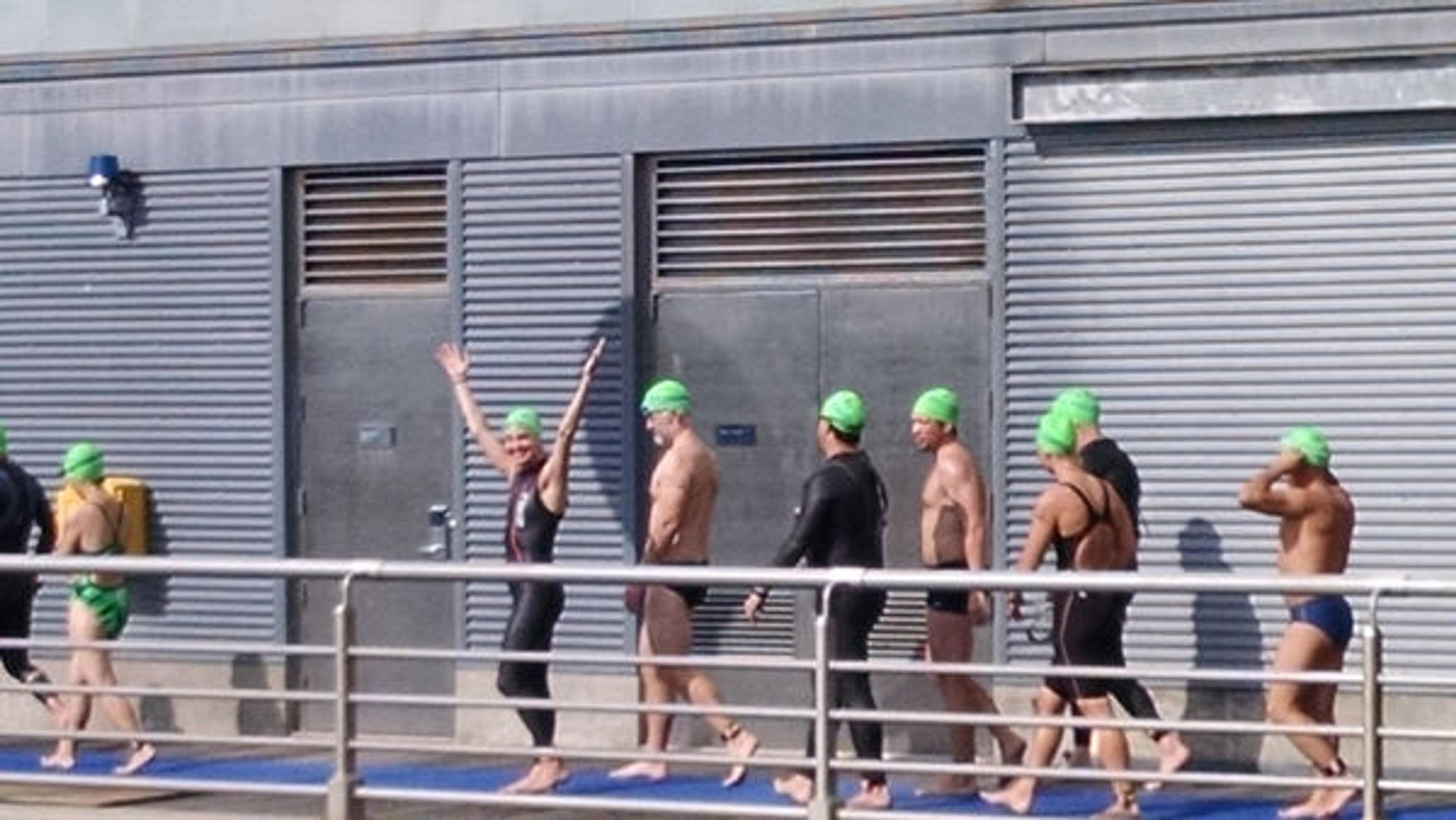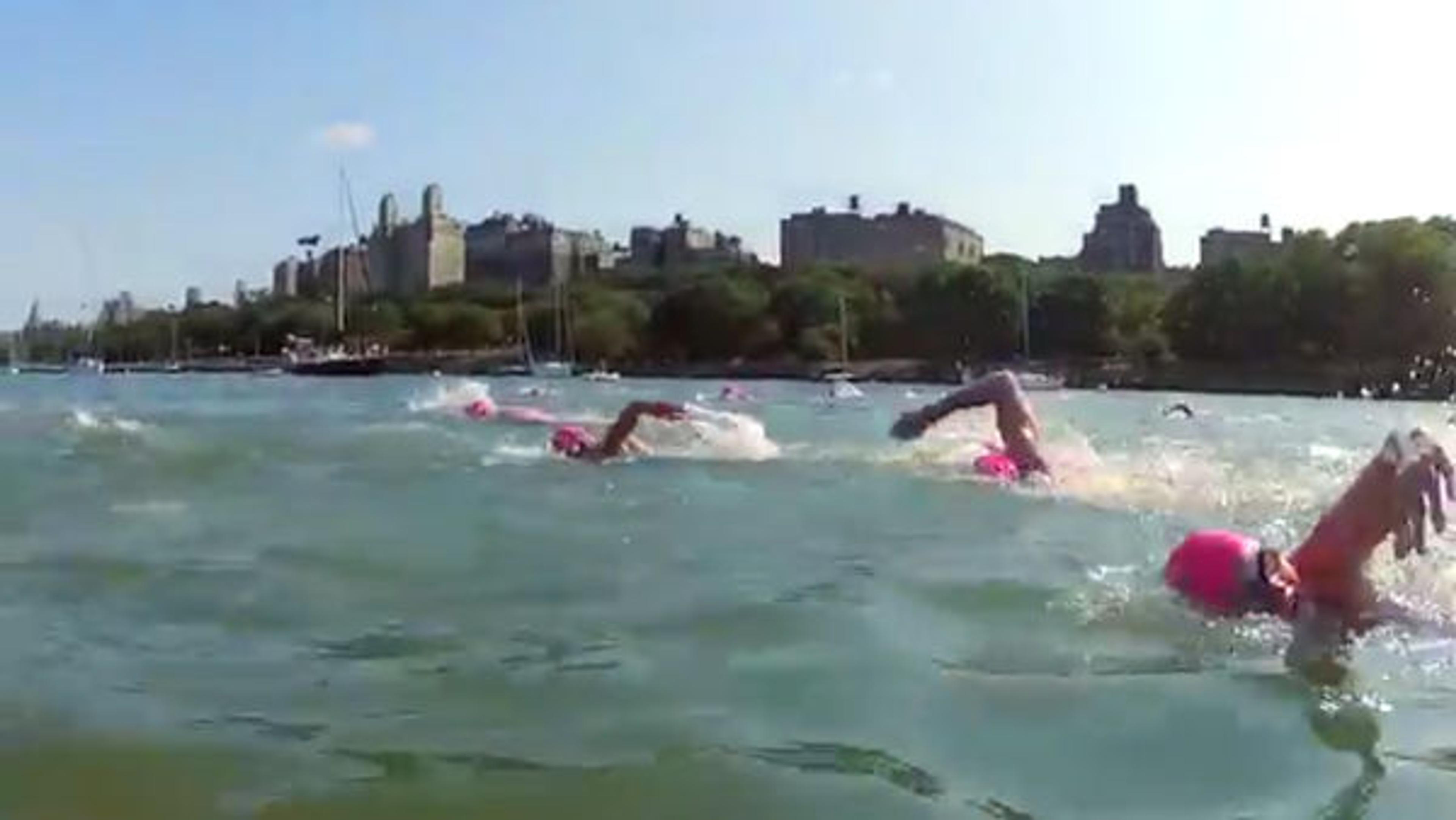
Swimmers (and me) lining up for the start of NYC Swim's Little Red Lighthouse 7.5-mile swim. Photograph by Patrick Duffy
«Saturday, September 20, was a bright, sunny day, a perfect day for a late-summer swim. While many New Yorkers enjoyed the beaches and lakes that afternoon, an intrepid—some would say crazy—group of about 250 swimmers took their dip in the Hudson River, sliding in off the kayak pontoon at Pier 96, at 56th Street.»
For us swimmers, it was just another Saturday with the group from NYC Swim, the angels and advocates of the Hudson River who for twenty years have been revitalizing the historic aquatic traditions of our estuary. This summer, some of us had swum under the Brooklyn Bridge from Brooklyn to Manhattan, around Governor's Island, and most recently—just the Thursday before—around the Statue of Liberty. Today, that bond would take us 7.5 miles, past the George Washington Bridge to La Marina at Dyckman Street. For me, I thought of it as a swim to The Cloisters museum and gardens, the tower of which would assure us that the finish line was very near.
Answers to the frequently asked questions: the Hudson River tastes salty, is clean, and feels warm. Sea life thrives, and jellyfish abound—a good sign of river health. On the day of this particular swim, the water temperature was about 71 degrees, so many of us wore wetsuits. Tricky to get into—a swimmer ritual is helping each other zip up—the layer of neoprene quickly turns the group into seals, but with neon-colored caps so that we can be seen in the water.

Fellow swimmers making their way up the Hudson River. Photograph by Carrie Rebora Barratt
I've done many of these swims, the first back in 2005 with a good degree of fear of the water and dread of the aftermath, both of which were quickly dispelled by the sheer adrenaline that rises from swimming off the coast of Manhattan (or Brooklyn) and a huge and ever-growing respect for the great river. We swim with the fast current, abide by the choppy waves, and try to drink as little of it as possible, leaving the river in the river and not our bellies. On this particular swim, though, my nerves were wracked as the organizers had just three days earlier added 1.3 miles to the course. Somehow, the usual starting spot near the Boat Basin at 79th Street had been closed off to us, hence the move to 56th Street for the jump in. The "real" swimmers shrugged it off—another mile was just another ten minutes in the water—but for me and other recreational swimmers, that extra distance was daunting. Now the sight of The Cloisters was about 7 miles away, rather than 5.5.
The water itself is calming. Putting one arm in front of the other in repetition becomes a swimming meditation: just me, alone with my thoughts, looking up from time to time to spot another swimmer and ahead to the George Washington Bridge looming in the distance. For the first few miles of the course, the bridge does not seem to be getting any closer, just a distant goal. Better, I decided, to look at the Upper West Side passing by with every stroke. I breathe to the right, so first I saw the Boat Basin, then my own apartment building at 97th Street, Grant's Tomb, Riverside Church, Riverbank State Park, and soon enough, the Little Red Lighthouse at the base of the bridge and the great bridge itself. I stopped to tread water under the bridge, looked up, and then smiled at a swimmer next to me. Just incredible.

The tower at The Cloisters, as seen from the water. Photograph by Carrie Rebora Barratt
The 1.5 miles from the bridge to the finish is the most difficult, mentally and physically. Without the bridge as the goal, and after hours of swimming, it is a test of fortitude to keep it going the final distance. My savior in that moment was, indeed, The Cloisters. Its great central tower looming over the trees signaled that I was nearly home. The medieval branch of the Museum, where I have worked for the past thirty years, The Cloisters is full of treasures—tapestries, sculptures, objects of ritual and devotion, stained-glass windows, and a lush garden. I distracted myself during the final mile of the swim by thinking of walking through the galleries, seeking out my favorite works of art. When I finally climbed the ladder out of the water at La Marina three hours and fourteen minutes after the start, I looked back at the tower in gratitude. Home.